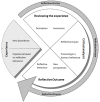Factors confounding the assessment of reflection: a critical review
- PMID: 22204704
- PMCID: PMC3268719
- DOI: 10.1186/1472-6920-11-104
Factors confounding the assessment of reflection: a critical review
Abstract
Background: Reflection on experience is an increasingly critical part of professional development and lifelong learning. There is, however, continuing uncertainty about how best to put principle into practice, particularly as regards assessment. This article explores those uncertainties in order to find practical ways of assessing reflection.
Discussion: We critically review four problems: 1. Inconsistent definitions of reflection; 2. Lack of standards to determine (in)adequate reflection; 3. Factors that complicate assessment; 4. Internal and external contextual factors affecting the assessment of reflection.
Summary: To address the problem of inconsistency, we identified processes that were common to a number of widely quoted theories and synthesised a model, which yielded six indicators that could be used in assessment instruments. We arrived at the conclusion that, until further progress has been made in defining standards, assessment must depend on developing and communicating local consensus between stakeholders (students, practitioners, teachers, supervisors, curriculum developers) about what is expected in exercises and formal tests. Major factors that complicate assessment are the subjective nature of reflection's content and the dependency on descriptions by persons being assessed about their reflection process, without any objective means of verification. To counter these validity threats, we suggest that assessment should focus on generic process skills rather than the subjective content of reflection and where possible to consider objective information about the triggering situation to verify described reflections. Finally, internal and external contextual factors such as motivation, instruction, character of assessment (formative or summative) and the ability of individual learning environments to stimulate reflection should be considered.
Figures
Similar articles
-
[Psychometric characteristics of questionnaires designed to assess the knowledge, perceptions and practices of health care professionals with regards to alcoholic patients].Encephale. 2004 Sep-Oct;30(5):437-46. doi: 10.1016/s0013-7006(04)95458-9. Encephale. 2004. PMID: 15627048 Review. French.
-
The future of Cochrane Neonatal.Early Hum Dev. 2020 Nov;150:105191. doi: 10.1016/j.earlhumdev.2020.105191. Epub 2020 Sep 12. Early Hum Dev. 2020. PMID: 33036834
-
Student and educator experiences of maternal-child simulation-based learning: a systematic review of qualitative evidence protocol.JBI Database System Rev Implement Rep. 2015 Jan;13(1):14-26. doi: 10.11124/jbisrir-2015-1694. JBI Database System Rev Implement Rep. 2015. PMID: 26447004
-
The Effectiveness of Integrated Care Pathways for Adults and Children in Health Care Settings: A Systematic Review.JBI Libr Syst Rev. 2009;7(3):80-129. doi: 10.11124/01938924-200907030-00001. JBI Libr Syst Rev. 2009. PMID: 27820426
-
Reflection: a critical proficiency essential to the effective development of a high competence in communication.J Vet Med Educ. 2006 Spring;33(1):58-64. doi: 10.3138/jvme.33.1.58. J Vet Med Educ. 2006. PMID: 16767639 Review.
Cited by
-
Does reflection have an effect upon case-solving abilities of undergraduate medical students?BMC Med Educ. 2012 Aug 13;12:75. doi: 10.1186/1472-6920-12-75. BMC Med Educ. 2012. PMID: 22889271 Free PMC article.
-
Reflect to interact - fostering medical students' communication through reflection-focused e-learning.BMC Med Educ. 2024 May 15;24(1):541. doi: 10.1186/s12909-024-05368-4. BMC Med Educ. 2024. PMID: 38750528 Free PMC article.
-
Psychometric Evaluation of the Core Competencies in Disaster Nursing Scale for Disaster Rescue Nurses in Mainland China.J Nurs Manag. 2025 Aug 10;2025:9957270. doi: 10.1155/jonm/9957270. eCollection 2025. J Nurs Manag. 2025. PMID: 40831785 Free PMC article.
-
Do photographs, older adults' narratives and collaborative dialogue foster anticipatory reflection ("preflection") in medical students?BMC Med Educ. 2016 Nov 11;16(1):289. doi: 10.1186/s12909-016-0802-2. BMC Med Educ. 2016. PMID: 27835991 Free PMC article.
-
A systematic scoping review of reflective writing in medical education.BMC Med Educ. 2023 Jan 9;23(1):12. doi: 10.1186/s12909-022-03924-4. BMC Med Educ. 2023. PMID: 36624494 Free PMC article.
References
Publication types
MeSH terms
LinkOut - more resources
Full Text Sources


